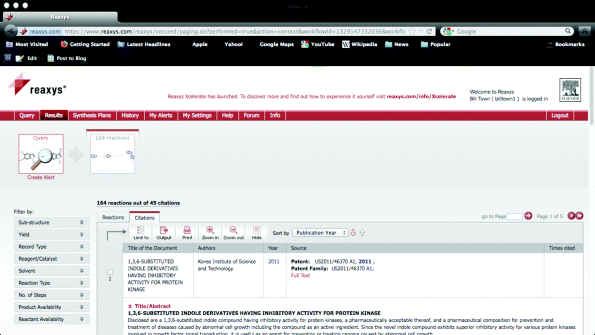Appendix A
The Literature of Organic Chemistry
All discoveries in the laboratory must be published somewhere if the information is to be made available to the scientific community. A new experimental result that is not published is useless, insofar as it benefits the entire chemical world. Traditionally, the total body of chemical knowledge (called the literature) is located on the combined shelves of all the chemical libraries in the world. Nowadays, books remain on library shelves, but many, if not most, chemical journals are available online. As e-books become increasingly available, however, books will be available online or for personal electronic reading devices. Anyone who wishes to learn the answer to a chemical question will access the chemical literature, both books and original articles in journals. The expressions “is known”, “has been done”, and so on, usually means “has been published”. The contents of the scientific literature may appear formidably large, but the process of extracting information from the literature of organic chemistry is usually manageable. Appendix A examines both the print literature of organic chemistry1 and, within reasonable limits, electronic forms of the literature.
It is quite clear that the literature can be divided into two broad categories: primary sources and secondary sources. A primary source publishes the original results of laboratory investigations, usually in scientific journals. Indeed, the two chief kinds of primary source are journals and patents. Books, indexes, and other publications that cover material that has previously been published in primary sources are called secondary sources. Electronic search engines that use primary sources as a database are also considered to be secondary sources. It is because of the excellence of the secondary sources in organic chemistry (especially Chemical Abstracts, SciFinder) that literature searching is comparatively straightforward.
A. Primary Sources
A.i. Journals
For well over 100 years, nearly all new work in organic chemistry (except for that disclosed in patents) has been published in journals. There are many journals that publish chemical papers, in many countries and in many languages. Nowadays, a high percentage of the journals are published in English, but not all. Some print papers cover all fields of science; some are restricted to chemistry; some to organic chemistry; and some are still more specialized. As noted above, many journals are now available in electronic form.2 The actual article is usually offered as an html file, or a PDF file, often with links to the cited references. The vast majority of important papers in “pure” organic chemistry (as opposed to “applied”) are published in relatively few journals, perhaps 50 or fewer. The concept of “pure” organic chemistry is not as useful nowadays because organic chemistry is important in many areas, and multidisciplinary research often includes organic chemistry. Literature that is important to an organic chemist is found in journals and patents that focus on bioorganic, organometallic, materials science, polymer science, separation science, medicinal chemistry, pharmaceutical sciences, and medicine to name a few. The reader is therefore cautioned that the journals listed in this section have organic chemistry as their primary focus, but are by no means the only sources of information concerning organic chemistry. The literature is vast and many journals are published weekly and some semimonthly.
Ordinary papers, usually referred to as full papers, usually include full experimental details, either as part of the paper itself or as accompanying supplemental information. Such details are the mainstay of modern research, providing a guide to what has been done, and the experimental details allow one to repeat that work. With the increase in the volume of chemical literature, and especially with the proliferation of electronic journals, and as noted above, many journals now place full experimental details into “Supplemental Information”. For journals published by the American Chemical Society, a URL link is provided for each article that contains the supplemental information: experiential details, spectral data, visual reproductions of spectral data, X-ray crystallographic data, and so on. Other publishers offer similar links. Once a paper is accepted, the online version (e.g., American Chemical Society ASAP papers) can be found before the print version or the full electronic version that contains the page numbers appear.
In addition to full papers, there are two other types of publications in which original work is reported: notes and communications. A note is a brief paper, often without a summary (nearly all papers are published with summaries or abstracts prepared by the author). Otherwise, a note is similar to a paper.3 Some journals specialize in publishing only notes. Communications (also called letters) are also brief and are usually without summaries (some journals now publish summaries along with their communications), and there are journals that publish only communications or letters.
Communications differ from notes and papers in three respects:
Although chemical publications are published in many languages, the vast majority of important papers in organic chemistry are published in English. For example, six prominent European journals (Chemische Berichte, Liebigs Annalen der Chemie, Bulletin de la Société Chimique de France, Bulletin des Sociétés Chimique Belges, Recueil des Travaux Chimiques des Pays-Bas, and Gazzetta Chimica Italiana) were discontinued. In their place is the European Journal of Organic Chemistry, published in English. Most of the articles published in other languages have summaries printed in English also. Important papers were published in German and French for >200 years, and these are generally not available in translation, so that the organic chemist was required to have at least a reading knowledge of these languages. Before ~1920, more than one-half of the important chemical papers were in these languages. In recent years, however, fewer papers in French or German have appeared without an English translation. Of course, a reading knowledge of French and German (especially German) is critical for the older literature. It must be realized that the original literature is never obsolete. With the rise of China in the scientific community, journals are published in Chinese, and there are journals and important chemical discoveries published in Japanese. Work by Chinese and Japanese scientists regularly appears in English-language journals. Secondary sources become superseded or outdated, but nineteenth century journals with primary literature are found in most chemical libraries and are still consulted. Table A.1 presents a list of important current journals that publish original papers4 and communications in organic chemistry. Some of them also publish review articles, book reviews, and other material. In 1999, the Journal of Organic Chemistry stopped publishing communications, and these are now published in Organic Letters.
Table A.1 A List of the More Important Current Journalsa
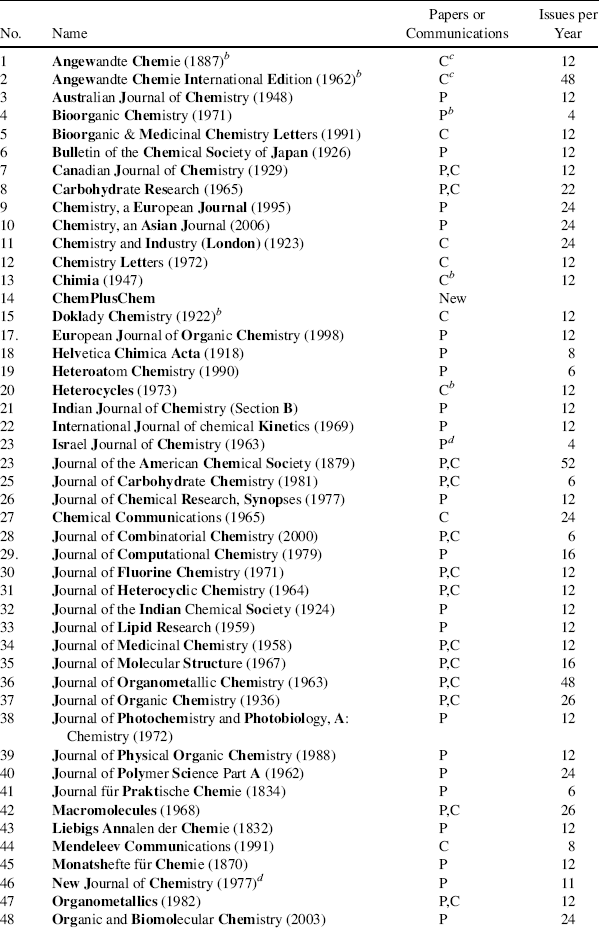
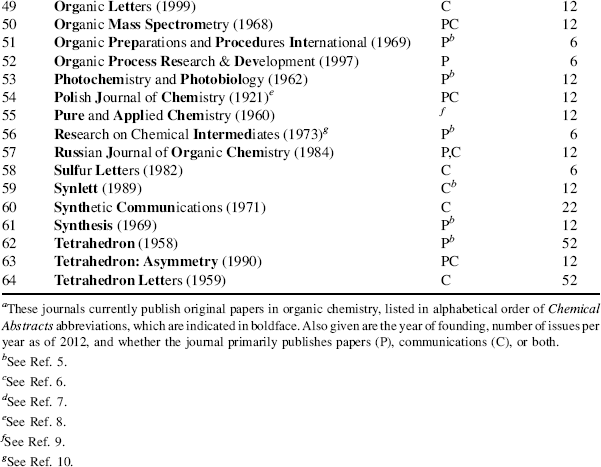
For some years, the American Chemical Society journals, including J. Am. Chem. Soc. and J. Org. Chem., provided supplementary material for some of their papers on microfilm or microfiche. As noted above, this material is now available online, and for older literature from the Microforms and Back Issues Office at the ACS Washington office, either on microfiche, or as a photocopy. These practices have not yet succeeded in substantially reducing the total volume of the world's primary chemical literature since many new journals have appeared, and the yearly page count for most journals has doubled or tripled.
A.ii. Patents
In many countries, including the United States, it is possible to patent a new compound or a new method for making a known compound (either laboratory or industrial procedures). It comes as a surprise to many to learn that a substantial proportion of the patents granted (perhaps 20–30%) have been chemical patents. Chemical patents are part of the chemical literature, and both U.S. and foreign patents were regularly abstracted by Chemical Abstracts and now SciFinder. In addition to learning about the contents of patents from this source, chemists may consult the Official Gazette of the U.S. Patent Office, which, published weekly and available in many libraries, lists titles of all patents issued that week. Bound volumes of all U.S. patents are kept in a number of large libraries, including the New York Public Library, which also has an extensive collection of foreign patents. Photocopies of any U.S. patent and most foreign patents were obtained at low cost from the U.S. Patent and Trademark Office, Washington, DC, 20231. Many patents can now be obtained online as well or are available as PDF files. Patents are also available via SciFinder (formerly, CAS online).
Although patents are often very useful to the laboratory chemist, and no literature search is complete that neglects relevant patents, as a rule they are not as reliable as papers. There are two reasons for this finding:
Fortunately, the above statements do not apply to all chemical patents: many make full disclosures and claim only what was actually done. It must also be pointed out that it is not always possible to duplicate the work reported in every paper in a journal due to the use of proprietary catalysts or equipment not available to the public. It is not uncommon to literally purchase the world's supply of a key ingredient. Note, however, that some work is not published or patented but rather maintained within the company as a trade secret. Such work is not, of course, available to the public.
B. Secondary Sources
Journal articles and patents contain virtually all of the original work in organic chemistry. However, if this were all, if there were no indexes, abstracts, review articles, and other secondary sources, the literature would be unusable, because it is so vast that no one could hope to find anything in particular. Fortunately, the secondary sources are excellent. There are various kinds and the classification shown here is somewhat arbitrary.
B.i. Listings of Titles
The profusion of original papers is so great that publications that list the titles of current papers find much use. Such lists are primarily methods of alerting the chemist to useful papers published in journals that are not normally read. This approach using print versions containing lists or journals and articles is used sparingly nowadays. Most journals are available online with useful search engines, and most have the original papers, with supplemental material, as html and PDF11 documents. The PDF document can be downloaded to the searcher's desktop, sometimes for a fee, shipped to other scientists electronically, and is most convenient. Chemical Abstracts was available online as CAS OnLine, but this service has been supplanted by SciFinder (see Appendix A.D.iii). University libraries and companies pay the appropriate fees, so access to the journals is usually quite easy if one is affiliated with these organizations. Search engines allow one to quickly scan an enormous amount of literature from office or home. In addition, most browsers have online searching capabilities via various search engines, and simply typing in an author, a topic, a chemical, or a few keywords can lead to important articles or information. “Google® searching”12 is commonly employed for a “quick and dirty” search, but one is strongly urged to use one of the established scientific search engines for a proper search. The more important online technology will be discussed below. However, some other resources13 include Specialty Citation Indexes Science Citation Index Expanded™, Web of Science®, Science Citation Index®, ISI ProceedingsSM, Reaction Citation Index™, and the Derwent Innovations IndexSM. The discussion will begin with the older print versions for chemical searches.
A print-version “title” publication covering the whole of chemistry is Current Contents Physical, Chemical & Earth Sciences,14 which began in 1967 and appears weekly, contains the contents pages of all issues of about 800 journals in chemistry, physics, earth sciences, mathematics, and allied sciences. Each issue contains an index of important words taken from the titles of the papers listed in that issue, and an author index, which, however, lists only the first-named author of each paper. The author's address is also given, so that one may write for reprints. An online service is available called Current Contents Connect® is a multidisciplinary Web resource providing access to complete bibliographic information from >8000 of the world's leading scholarly journals and >2000 books.15
Chemical titles is a similar publication produced by the Chemical Abstracts Service (CAS). SciFinder described below allows one to search a variety of databases, including journal titles.
B.ii. Abstracts
Listings of titles are valuable, as far as they go, but they do not tell what is in the paper, beyond the implications carried by the titles. Most current journals contain a graphic abstract, as well as a title and a brief print description of the research. The graphical abstract is extremely useful for scanning the literature presented in a journal, and both the print and graphical abstracts are available online for most journals.
From the earliest days of organic chemistry, abstracts of papers have been widely available, often as sections of journals whose principal interests lay elsewhere.16 At the present time there are only two publications entirely devoted to abstracts covering the whole field of chemistry. One of these, Referativnyi Zhurnal, Khimiya, which began in 1953, is published in Russian and is chiefly of interest to Russian-speaking chemists. The other is Chemical Abstracts, which was published until 2010. Abstracts are now available online via SciFinder. Although out of print, knowledge of Chemical Abstracts is important to properly do a literature search that includes older literature. Chemical Abstracts appeared weekly and printed abstracts in English of virtually every paper containing original work in pure or applied chemistry published anywhere in the world.17 More than 18,000 journals were covered, in many languages. In addition, CA published abstracts of every patent of chemical interest from 18 countries, as well as many patents from additional countries. The abstracts currently appeared in 80 sections, with sections 21–34 devoted to organic chemistry, under such headings as Alicyclic Compounds, Alkaloids, Physical Organic Chemistry, Heterocyclic Compounds (One Heteroatom), and so on. Each abstract of a paper had a heading that gave (1) the abstract number;18 (2) the title of the paper; (3) the authors' names as given in the paper; (4) the authors' address; (5) the abbreviated name of the journal (see Table A.1);19 (6) the year, volume, issue, and page numbers; and (7) the language of the paper. In earlier years CA gave the language only if it differed from the language of the journal title. Abstracts of patents showed the abstract number, title, inventor and company (if any), patent number, patent class number, date patent issued, country of priority, patent application number, date patent applied for, and number of pages in the patent. The body of the abstract contained a concise summary of the information in the paper. For many common journals, the author's summary (if there is one) was used in CA as it appeared in the original paper, with perhaps some editing and additional information. Each issue of CA contained an author index, a patent index, and an index of keywords taken from the titles and the texts or contexts of the abstracts. The patent index listed all patents in order of number. The same compound or method is often patented in several countries. Chemical Abstracts abstracted only the first patent, but listed the patent numbers of the duplicated patents in the patent index along with all previous patent numbers that correspond to it. Before 1981 there were separate Patent Number Indexes and Patent Concordances (the latter began in 1963).
At the end of each section of CA a list of cross-references to related papers in other sections is given.
Chemical Abstracts is useful as a repository of chemical information, a place for finding out what was done in the past. This value stems from the excellent indexes, which enable the chemist in most cases to ascertain quickly where information is located. From the time of its founding in 1907 until 1961, CA published annual indexes. After 1962 there were two volumes published each year, and a separate index is issued for each volume. Each volume contained an index of subjects, authors, formulas, and patent numbers. Beginning in 1972, the subject index was issued in two parts, a chemical substance index and a general subject index, which included all entries that are not the names of single chemical substances. However, the indexes to each volume were essentially superseded by each collective index. The first collective indexes were 10-year (decennial) indexes, but the volume of information made 5-year indexes necessary since 1956. Collective indexes so far published are shown in Table A.2.
Table A.2 CA Collective Indexes So Far Published.
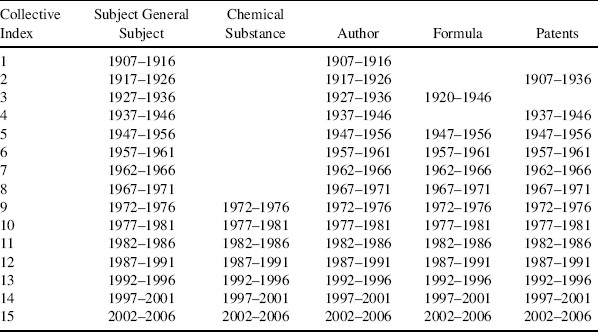
As noted above, the print form of Chemical Abstracts has been superseded by SciFinder (see Appendix A.D.iii)
Beginning with the Eighth collective index period, CA has published an Index Guide. This publication gave structural formulas and/or alternate names for thousands of compounds, as well as many other cross-references. It was designed to help the user efficiently and rapidly to find CA references to subjects of interest in the general subject, formula, and chemical substance indexes. Each collective index contained its own Index Guide. The Index Guide was necessary because the CA general subject index was a “controlled index”, meaning it restricted its entries only to certain terms.
For example, anyone looking for the term “refraction” in the printed general subject index will not find it. The Index Guide included this term, and directed the reader to “Electromagnetic wave, refraction of”, “Sound and ultrasound, refraction of”, and other terms, all of which were found in the general subject index. Similarly, the chemical substance index usually listed a compound only under one name - the approved CA name. Trivial and other names were found in the Index Guide. For example, the term “methyl carbonate” is not in the chemical substance index, but the Index Guide does have this term, and directs the reader to the chemical substance index under the headings “carbonic acid, esters, dimethyl ester” (for Me2CO3) and “carbonic acid, esters, monomethyl ester” (for MeHCO3). Furthermore, the Index Guide gives terms related to the chosen term, helping users to broaden a search. For example, one who looks for “Atomic orbital” in the Index Guide will find the terms “Energy Level”, “Molecular orbital”, “Atomic integral”, and “Exchange, quantum mechanical, integrals for”, all of which are controlled index terms.
Each index (annual, semiannual, or collective) also provided an index of ring systems. This valuable index enables the user to ascertain immediately if any ring system appears in the corresponding subject or chemical substance index and under what names. For example, someone wishing to determine whether any compounds

containing the benz(h)isoquinoline ring system are reported in the 1982–1986 collective index would locate, under the heading “3-ring systems”, the listing 6, 6, 6 (since the compound has three rings of six-members each), and would find the sublisting C5N–C6–C6 (since one ring contains five carbons and a nitrogen while the others are all-carbon), under which is listed the name benz(h)isoquinoline, as well as the names of 30 other systems C5N–C6–C6. A search of the chemical substance index under these names will give all references to these ring systems that appeared in CA from 1982 to 1986.
Nowadays, the drawing tools of SciFinder (sec. Appendix A.D.iii) are used to draw this structure, and then perform the search.
Before 1967, CA used a two-column page, with each column separately numbered. A row of letters from a to h appeared down the center of the page for the guidance of the user. Thus an entry 7337b refers to the b section of column 7337. In early years, superscript numbers (e.g., 43275) were used in a similar manner. In very early years, these numbers were not printed on the page at all, though they are given in the decennial indexes, so that the user must mentally divide the page into nine parts. Beginning with 1967, abstracts are individually numbered and column numbers are discarded. Therefore, beginning with 1967, index entries give abstract number rather than column number. The abstract numbers are followed by a letter that serves as a check character to prevent miscopying errors in computer handling. To use the CA general subject, chemical substance, and formula indexes intelligently requires practice, and the student should become familiar with representative volumes of these indexes and with the introductory sections to them, as well as with the Index Guides.
In the CA formula indexes, formulas were listed in order of (1) number of carbon atoms; (2) number of hydrogen atoms; (3) other elements in alphabetic order. Thus, all C3 compounds are listed before any C4 compound; all C5H7 compounds before any C5H8 compound; C7H11Br before C7H11N; C9H6N4S before C9H6O, and so on. Deuterium and tritium are represented by D and T and treated alphabetically (e.g., C2H5DO after C2H5Cl and before C2H5F or C2H6).
Since 1965, CA has assigned a Registry Number20 to each unique chemical substance. This is a number of the form [766-51-8] that remains invariant, no matter what names are used in the literature. More than 64 million numbers have already been assigned and thousands are added each week. Registry Numbers are primarily for computer use, but chemical suppliers use CAS registry numbers to identify chemicals that are available for sale.
There were a number of earlier abstracting publications now defunct. The most important are Chemisches Zentralblatt and British Abstracts. These publications are still valuable because they began before CA and can therefore supply abstracts for papers that appeared before 1907. Furthermore, even for papers published after 1907, Zentralblatt and British Abstracts are often more detailed. Zentralblatt was published, under various names, from 1830 to 1969.21British Abstracts was a separate publication from 1926 to 1953, but earlier abstracts from this source are available in the Journal of the Chemical Society from 1871 to 1925.
B.iii. Beilstein
This publication has been so important to organic chemistry that it deserves a section by itself. Beilstein's Handbuch der Organischen Chemie, usually referred to as Beilstein, lists all the known organic compounds reported in the literature during its period of coverage. The print version will be described first, as it is particularly important for older literature.
For each compound in Beilstein, the following data are given: all names; the molecular formula; the structural formula; all methods of preparation (briefly, e.g., “by refluxing 1-butanol with NaBr and sulfuric acid”); physical constants (melting point, refractive index, etc.); other physical properties; chemical properties including reactions; occurrence in nature (i.e., which species it was isolated from); biological properties, if any; derivatives with melting points; analytical data, and any other information that has been reported in the literature.22 Equally important, for every piece of information, a reference is given to the original literature. Furthermore, the data in Beilstein have been critically evaluated. That is, all information is carefully researched and documented, and duplicate and erroneous results are eliminated. Some compounds are discussed in two or three lines and others require several pages.
The print editions are invaluable for searching older literature, but even today provide valuable data for many compounds used every day. A discussion of using Beilstein is therefore essential.
The first three editions of Beilstein are obsolete. The fourth edition (vierte Auflage) covers the literature from its beginnings through 1909. This edition, called das Hauptwerk, consists of 27 volumes. The compounds are arranged in order of a system too elaborate to discuss fully here.23 The compounds are divided into three divisions that are further subdivided into “systems”:
| Division | Volumes | System Numbers |
| I. Acyclic Compounds | 1–4 | 1–499 |
| II Carbocyclic Compounds | 5–16 | 450–2359 |
| III. Heterocyclic Compounds | 17–27 | 2360–4720 |
Das Hauptwerk is still the basis of Beilstein and has not been superseded. The later literature is covered by supplements that have been arranged to parallel das Hauptwerk. The same system is used, so that the compounds are treated in the same order. The first supplement (erstes Ergänzungswerk) covers 1910–1919; the second supplement (zweites Ergänzungwerk) covers 1920–1929; the third supplement (drittes Ergänzungswerk) covers 1930–1949; the fourth supplement (viertes Ergänzungswerk) covers 1950–1959, and the fifth supplement covers 1960–1979. Like das Hauptwerk, each supplement contains 27 volumes,24 except that supplements 3 and 4 are combined for Vols. 17–27, so that for these volumes the combined third and fourth supplement covers the years 1930–1959. Each supplement has been divided into volumes in the same way as das Hauptwerk, and, for example, compounds found in Vol. 3, system number 199 of das Hauptwerk will also be found in Vol. 3, system number 199 of each supplement. To make cross-referencing even easier, each supplement gives, for each compound, the page numbers at which the same compound can be found in the earlier books. Thus, on page 554 of Vol. 6 of the fourth supplement, under the listing phenetole are found the symbols (H 140; E I 80; E II 142; E III 545) indicating that earlier information on phenetole is given on page 140 of Vol. 6 of das Hauptwerk, on page 80 of the first, page 142 of the second, and page 545 of the third supplement. Furthermore, each page of the supplements contains, at the top center, the corresponding page numbers of das Hauptwerk. Since the same systematic order is followed in all six series, location of a compound in any one series gives its location in the other five. If a compound is found, for example, in Vol. 5 of das Hauptwerk, one has but to note the page number and scan Vol. 5 of each supplement until that number appears in the top center of the page (the same number often covers several pages). Of course, many compounds are found in only one, two, three, four, or five of the series, since no work may have been published on that compound during a particular period covered.
From das Hauptwerk to the fourth supplement, Beilstein is in German, but it is not difficult to read since most of the words are the names of compounds (a Beilstein German–English Dictionary, available free from the publisher, is in many libraries). For the fifth supplement (covering 1960–1979), which is in English, publication of Division III began before the earlier divisions. Volumes 17–22 (totaling 70 separate parts exclusive of index volumes) of this supplement have been published, as well as a combined index for volumes 17–19. This index covers only the fifth supplement. The subject portion of this index, which lists compound names only, gives these names in English.
Volumes 28 and 29 of Beilstein are subject and formula indexes, respectively. The most recent complete edition of these volumes is part of the second supplement and covers only das Hauptwerk and the first two supplements (though complete indexes covering das Hauptwerk and the first four supplements have been announced to appear in the next few years). For Vol. 1, there is a cumulative subject and a cumulative formula index, which combine das Hauptwerk and the first four supplements.25 Similar index volumes, covering all four supplements, have been issued for the other volumes, 2–27. Some of these are combined (e.g., 2–3, 12–14, and 23–25). For English-speaking chemists (and probably for many German-speaking chemists) the formula indexes are more convenient. Of course (except for the fifth supplement indexes), one must still know some German, because most formula listings contain the names of many isomers. If a compound is found only in das Hauptwerk, the index listing is merely the volume and page numbers (e.g., 1, 501). Roman numbers are used to indicate the supplements (e.g., 26, 15, I 5, II 7). Thus the subject and formula indexes lead at once to locations in das Hauptwerk and the first four supplements. The Beilstein formula indexes are constructed the same way as the CA indexes (Appendix A.B.ii).
There is also a fourth division of Beilstein (systems 4721–4877) that covers natural products of uncertain structure: rubbers, sugars, and so on. These are treated in Vols. 30 and 31, which do not go beyond 1935 and that are covered in the collective indexes. These volumes will not be updated. All such compounds are now included in the regular Beilstein volumes.
In recent years, Beilstein was available online, with the useful search engine CrossFire. However, this database is now incorporated into Reaxys (see Appendix A.D.vi).
B.iv. Tables of Information
In addition to Beilstein, there are many other print reference works in organic chemistry that are essentially compilations of data. These books are very useful and often save the research worker a great deal of time. In this section, we discuss some of the more important of such works.
 NMR, mass, and Raman spectra, as well as indexes of other names, molecular formulas, molecular weights, and physical constants. Annual updates began appearing in 1990 (the first one is called volume 10).
NMR, mass, and Raman spectra, as well as indexes of other names, molecular formulas, molecular weights, and physical constants. Annual updates began appearing in 1990 (the first one is called volume 10). NMR spectra is found in L.F. Johnson and W.C. Jankowski, Carbon-13 NMR Spectra, Wiley, New York, 1972.
NMR spectra is found in L.F. Johnson and W.C. Jankowski, Carbon-13 NMR Spectra, Wiley, New York, 1972.C. Reviews
A review article is an intensive survey of a rather narrow field. For example, the titles of some recent reviews are “Metathesis of Alkanes and Related Reactions”26, “Potassium Organotrifluoroborates: New Perspectives in Organic Synthesis”27, and “Asymmetric Addition of Allylic Nucleophiles to Imino Compounds”.28 A good review article is of enormous value, because it is a thorough survey of all the work done in the field under discussion. Review articles are printed in review journals and in certain books. The most important review journals in organic chemistry (though most are not exclusively devoted to organic chemistry) are shown in Table A.3. Some of the journals listed in Table A.1, for example, Chemical Reviews, Accounts of Chemical Research, and Synlett, Tetrahedron, Synthesis, Organic Preparations and Procedures International, and J. Organomet. Chem. also publish occasional review articles. As with other journals, journals that contain reviews are available online.
Table A.3 Review Journals, with Year of Founding and Issues per Year.
| Journal | Issues |
| Accounts of Chemical Research (1968) | 12 |
| Aldrichimica Acta (1968) | 4 |
| Angewandte Chemie (1888) | 12 |
| and its English Translation: | |
| Angewandte Chemie, International Edition (1962) | 12 |
| Chemical Reviews (1924) | 8 |
| Chemical Society Reviews (1947)a | 4 |
| Heterocycles (1973) | 12 |
| Natural Product Reports (1984) | 6 |
| Organic Preparations and Procedures International (1969) | 6 |
| Soviet Scientific Reviews, Section B, Chemistry Reviews (1979) Irreg. | |
| Sulfur Reports (1980) | 6 |
| Synlett (1989) | 12 |
| Synthesis (1969) | 12 |
| Tetrahedron (1958) | 52 |
| Topics in Current Chemistry (1949)b | Irreg. |
| Uspekhi Khimii (1932) | 12 |
| and its English translation: Russian chemical Reviews (1960) | 12 |
| a. See Ref. 29 b. See Ref. 30 |
|
There are several open-ended serial publications that are similar in content to the review journals but are published irregularly (seldom more often than once a year) and are hardbound. Some of these publish reviews in all fields of chemistry; some cover only organic chemistry; some specialize further. The coverage is indicated by the titles. Table A.4 shows some of the more important such publications, with CA abbreviations.
Table A.4 Irregularly Published Serial Publications.
| Advances in Carbocation Chemistry |
| Advances in Carbohydrate Chemistry and Biochemistry |
| Advances in Catalysis |
| Advances in Cycloaddition |
| Advances in Free Radical Chemistry |
| Advances in Heterocyclic Chemistry |
| Advances in Metal-Organic Chemistry |
| Advances in Molecular Modeling |
| Advances in Organometallic Chemistry |
| Advances in Oxygenated Processes |
| Advances in Photochemistry |
| Advances in Physical Organic Chemistry |
| Advances in Protein Chemistry |
| Advances in Theoretically Interesting Molecules |
| Fluorine Chemistry Reviews |
| Fortshritte der Chemie Organischer Naturstoffe |
| Isotopes in Organic Chemistry |
| Molecular Structure and Energetics |
| Organic Photochemistry |
| Organometallic Reactions |
| Organic Reactions |
| Organic Synthesis: Theory and Applications |
| Progress in Heterocyclic Chemistry |
| Progress in Macrocyclic Chemistry |
| Progress in Physical Organic Chemistry |
| Reactive Intermediates (Plenum) |
| Reactive Intermediates (Wiley) |
| Survey of Progress in Chemistry |
| Topics in Physical Organometallic Chemistry |
| Topics in Stereochemistry |
Another publication is the Index of Reviews in Organic Chemistry, complied by Lewis, Chemical Society, London, a classified listing of review articles. The first volume, published in 1971, lists reviews from ~1960 (in some cases much earlier) to ~1970 in alphabetical order of topic. Thus four reviews are listed under “Knoevenagel condensation”, five under “Inclusion compounds”, and one under “Vinyl ketones”. There is no index. A second volume (1977) covers the literature to 1976. Annual or biannual supplements appeared from 1979 until the publication was terminated in 1985. Classified lists of review articles on organometallic chemistry are found in articles by Smith and Walton31 and by Bruce.32 A similar list for heterocyclic chemistry is found in articles by A. Katritzky and others.33 See also the discussion of the Index of Scientific Reviews in Appendix A.D.iv.
C.i. Annual Reviews
The review articles discussed in Table A.3 are each devoted to a narrow topic covering the work done in that area over a period of years. An annual review is a publication that covers a broad area but limits the period covered, usually to 1 or 2 years.
C.ii. Awareness Services
Besides the annual reviews and the title and abstract services previously mentioned, there exist a number of publications designed to keep readers aware of new developments in organic chemistry or in specific areas of it.
C.iii. General Treatises
There are a number of large-scale multivolume treatises that cover the whole field of organic chemistry or large areas of it.
C.iv. Monographs and Treatises on Specific Areas
There are many books devoted to organic chemistry that provide a thorough coverage of a specific area. Many of these are essentially very long review articles, differing from ordinary review articles only in size and scope. Some are comprised of a series of articles, edited by an organic chemist for a specific area of research. Some of the books are by a single author, and others have chapters by different authors. All, however, are carefully planned to cover a specific area. Many of these books have been referred to in footnotes in appropriate places in this book. There have been several series of monographs, one of which is worth special mention: The Chemistry of Functional Groups, under the general editorship of Z. Rappoport (S. Patai was the original editor), published by Wiley, New York. Each volume deals with the preparation, reactions, and physical and chemical properties of compounds containing a given functional group. There are >130 volumes in the series, covering functional groups have appeared so far, including books on alkenes, cyano compounds, amines, carboxylic acids and esters, quinones, and so far. Since 2003, the series has appeared both in print and online.
C.v. Textbooks
There are many excellent textbooks in the field of organic chemistry. We restrict ourselves to listing only a few of those published, mostly since 1985. Some of these are first-year texts and some are advanced (advanced texts generally give references; first-year texts do not, though they may give general bibliographies, suggestions for further reading, etc.); some cover the whole field, and others cover reactions, structure, and/or mechanism only. All the books listed here are not only good textbooks and the advanced books are valuable reference books for graduate students and practicing chemists.
C.vi. Other Books
In this section, we mention several books that do not fit conveniently into the previous categories. All but the last have to do with laboratory synthesis.
| Annual Volumes | Collective Volumes |
| 1–9 | I |
| 10–19 | II |
| 20–29 | III |
| 30–39 | IV |
| 40–49 | V |
| 50–59 | VI |
| 60–64 | VII |
| 65–69 | VIII |
| 70–74 | IX |
| 75–80 | X |
| 81–84 | XI |
D. Literature Searching
Until recently, searching the chemical literature meant looking only at printed materials (some of which might be on microfilm or microfiche). Now, however, virtually all of the literature can be searched online. Whether the search is online or uses only the printed material, there are two basic types of search, (1) searches for information about one or more specific compounds or classes of compounds, and (2) other types of searches. First, we will discuss searches using only printed materials, and then online searching.35
D.i. Literature Searching Using Printed Materials
| Research Topic Candidates | References |
| 159 references were found containing the two concepts “macrolactones” | |
| and “hydroxy acids” closely associated with one another | 159 |
| 474 references were found where the two concepts “macrolactones” and | |
| “hydroxy acids” were present anywhere in the reference | 474 |
| 35157 references were found containing the concept “macrolactones” | 35157 |
| 193323 references were found containing the concept “hydroxy acids” | 193323 |
D.ii. Literature Searching Online20
Most of the Chemical Abstracts literature can be accessed online via CAS, using SciFinder in Appendix A.D.iii, the largest and most current database of chemical substance information in the world. CAS is located in Columbus, Ohio and is a division of the American Chemical Society. CAS can be contacted at Chemical Abstracts Service, 2540 Olentangy River Road, P.O. Box 3012, Columbus, Ohio 43210 (e-mail: help@cas.org). CAS is a team of scientists who provide digital information environment for scientific research and discovery. CAS provides pathways to published research in the world's journal and patent literature back to the beginning of the 20th century. Since 1907, CAS has indexed and summarized chemistry-related articles from >40,000 scientific journals, in addition to patents, conference proceedings and other documents pertinent to chemistry, life sciences, and many other fields. Through the printed CA (Chemical Abstracts), CA on CD, STN, the CAS files distributed through licensed vendors, the SciFinder and SciFinder Scholar desktop research tools, and the STN Easy or STN on the Web services, data produced by CAS is accessible to virtually any scientific researcher worldwide in industry, governmental research institutions, and academia.
Substance identification is a special strength of CAS. It is widely known as the CAS Registry, the largest substance identification system in existence. When a chemical substance, newly encountered in the literature, is processed by CAS, its molecular structure diagram, systematic chemical name, molecular formula, and other identifying information are added to the Registry and it is assigned a unique CAS Registry Number.
The CAS REGISTRY mostly covers substances identified from the scientific literature from 1957 to the present with some classes (fluorine- and silicon-containing compounds) going back to the early 1900s. An important piece of information that assists in such a search is the CAS registry number. Each substance in REGISTRY is identified by a unique numeric identifier called a CAS Registry Number.38 “The CAS Registry number is a unique number assigned to a chemical by the Chemical Abstracts Service.39 A fairly large collection of CAS numbers, with links to safety data for many chemicals, can be found at the listing of chemicals by CAS number at the Safety Home Page of the Physical and Theoretical Chemistry Laboratory at Oxford University”.40 The CAS Registry Number is a unique numeric identifier that designates only one substance, has no chemical significance, and is a link to finding information about a specific chemical substance. A CAS Registry Number includes up to 9 digits that are separated into 3 groups by hyphens. The first part of the number, starting from the left, has up to 6 digits; the second part has 2 digits. The final part consists of a single check digit.41
Online searching means using a computer terminal to search a database. Although databases in chemistry are available from several organizations, STN International (The Scientific & Technical Information Network) is important because it is comprehensive and available in many countries. STN has dozens of databases, including many that cover chemistry and chemical engineering. To access these databases a chemistry department, a library, or an individual subscribes to STN (for a nominal fee), and receives code numbers that will permit access to the system, usually via a desktop computer.
D.iii. SciFinder—the CAS database42
Tutorials are available to help use Sci-Finder.43 SciFinder can search a research topic44 or a compound can be searched by structure45 The search engine is known as STN Express with Discover!46 and can easily and efficiently search >200 scientific and technical databases online through STN®.47 The Analysis Edition of STN Express with Discover! allows one to search, analyze, visualize, and discover sci-tech information by the ability to create a table for substance analysis that identifies the common substructure for an answer set of structurally related substances: Group related author/inventor names and company names for better analysis and visualization results; Analyze and tabulate data from single- or multi-file search results, and create a data table and 3D chart; Save an answer set from databases (e.g., CAplusSM, PCTFULL, and USPATFULL) with the Save for STN AnaVist Wizard, and then import and open it in STN® AnaVistTM; Create an interactive spreadsheet from all or only hit CAS Registry Numbers and their corresponding CAS Roles through the CAS Registry Number®; Upload lengthy genetic sequences automatically for searching in DGENE and PCTGEN via the Upload Query Wizard. STN Express was developed in collaboration with Hampden Data Services.
To illustrate how STN is used, an online tutorial is available.48 A few online windows from a SciFinder search are provided to illustrate how searches can be done. This presentation is by no means complete or intended as an alternative to the actual tutorial. Indeed, one could not use SciFinder properly after simply reading this discussion. The intent is to illustrate some features that are available and to present an overview of the use of this important tool.
Using SciFinder®, a search can be done in one of several different ways. Searches can be done by research topic, by substances, or by reactions. The latter two searches use drawing tools that are part of SciFinder. An example is shown of a search done by research topic:49 The example shown in Fig. A.3. shows a search for intramolecular hydroamination of aminoalkenes. To begin, click Explore by research topic and enter the appropriate information.
It is possible to use filters (see Fig. A.1) in order to refine the search by year, document type (journal, patent, review, etc.), author or company. A window is returned that contain references categorized by their relationship to the search phrase, as shown in Fig. A.2. One simply checks those reference lists that appear closest to those of interest.
Fig. A.1 Explore by research topic.
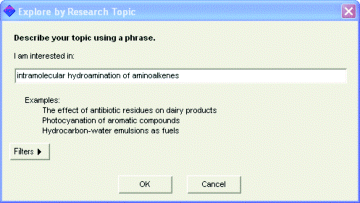
Fig. A.2 Selection of candidates of interest for search by research topic.
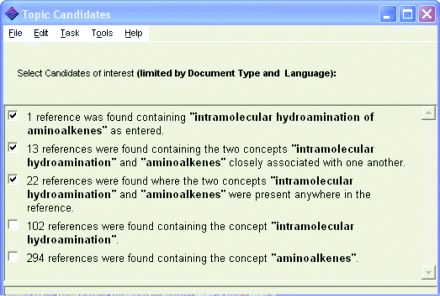
After clicking on “get references,” a screen is returned (Fig. A.3) that has the original references, as shown in the window. One is given the option of refining this list further, and for each reference, most browsers allow viewing the abstract or the full references as an HTML or a PDF file. However, your library must have paid the appropriate fees so the journal and volumes of interest are available online. Otherwise, interlibrary loan or direct ordering of the article may be necessary.
Fig. A.3 Original literature references returned for search by research topic.
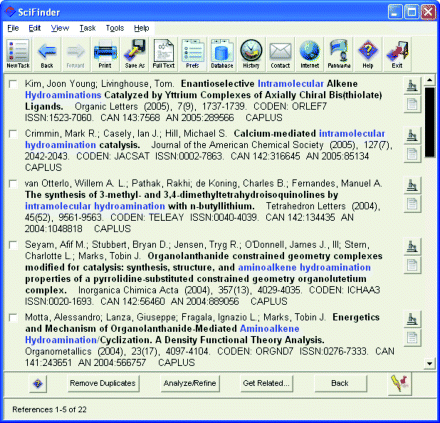
Other examples of typical searches allowed by SciFinder include search by author's name,50 as with the example of Professor K. Barry Sharpless shown in Fig. A.4. Search by structure is also possible,51 such as the example shown in Fig. A.5, using SciFinder drawing tools. Once a structure is drawn, SciFinder searches to find matches based on that structure. The drawing tools can be used to show a reaction, and reaction information is returned, as shown in Fig. A.6. Ultimately, journal article and/or patents are returned that provide direct access to the literature of interest.
Fig. A.4 Screen shot for beginning a search by author.
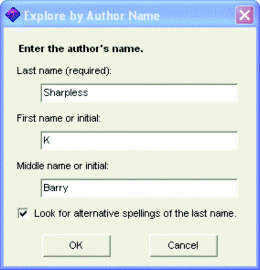
Fig. A.5 Screen shot for beginning a search by structure, using the drawing tools.
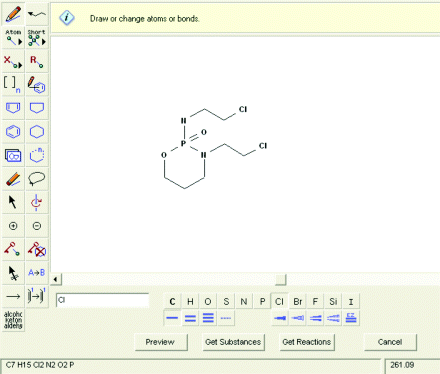
Fig. A.6 Screen shot of results for a search by reaction, using the drawing tools.
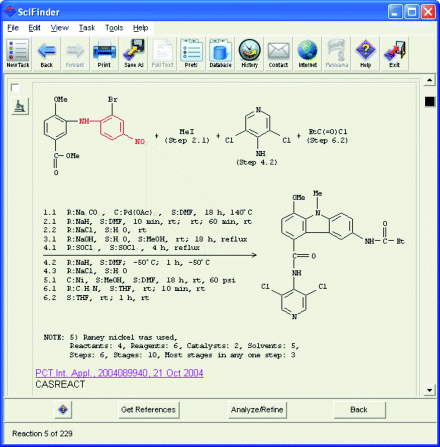
D.iv. Science Citation Index
As seen in the SciFinder search tutorials, it is possible to track papers that have cited a particular article or author. A publication that can greatly facilitate literature searching is Science Citation Index(SCI), begun in 1961. This publication, which is quite different from any other mentioned in this chapter, gives a list of all papers in a given year that have cited a given paper, patent, or book. Its utility lies in the fact that it enables the user to search forward from a given paper or patent, rather than backward, as is usually the case. For example, suppose a chemist is familiar with a paper by W.P. Jencks and M. Gilchrist (J. Am. Chem. Soc., 1968, 90, 2622) entitled “Nonlinear Structure–Reactivity Correlations. The Reactivity of Nucleophilic Reagents toward Esters”. The chemist is easily able to begin a search for earlier papers by using references supplied in this paper and can then go further backward with the aid of references in those papers, and so on. But for obvious reasons the paper itself supplies no way to locate later papers. Science Citation Index is designed to make up for this gap. The citation index of SCI lists all papers, patents, or books cited in a given year or 2-month period (by first author only) and then gives a list of papers that have done the citing. The index is published bimonthly and cumulated annually. For example, column 43901 of the 1989 citation index shows that the Jencks paper mentioned above was cited as a footnote in 16 papers published in 1989. It is reasonable to assume that most of the papers that cited the Jencks paper were on closely related subjects. For each of the 16 papers are listed the first author, journal abbreviation, volume and page numbers, and year. In a similar manner, if one consulted SCI for all the years from 1968 to date, one would have a complete list of papers that cited that paper. One could obviously broaden the search by then consulting SCI (from 1989 on) for papers that cited these 16 papers, and so on. Papers, patents, or books listed (e.g., in the 1989 SCI) may go back many years (e.g., papers published by A. Einstein in 1905 and 1906 are included). The only requirement is that a paper published in 1989 (or late 1988) has mentioned the earlier paper in a footnote. The arrangement of cited papers or books is alphabetical by cited first author and then by cited year. Cited patents are listed in a separate table, in order of patent number, though the inventor and country are also given.
SCI covers ~3200 journals in the physical and biological sciences, as well as in medicine, agriculture, and technology. In addition to the citation index, each bimonthly and annual SCI also includes three other indexes. One of these, called Source Index, is similar to the CA author index. It lists the titles, journal abbreviations, volume, issue, page numbers, and year of all papers published by a given author during that 2-month period or year. All authors are listed; not just first authors. The second, called the Corporate Index, lists all publications that have been published from a given institution during that period, by first author. Thus, the corporate index for 1989 lists 63 papers by 45 different first authors emanating from the Department of Chemistry of Rutgers University, New Brunswick, NJ. The main section of the corporate index (the Geographic Section) lists institutions by country or (for the US) by state. There is also an Organization Section, which lists the names of institutions alphabetically, and for each gives the location, so it can be found in the geographic section. The third index included in SCI is the Permuterm52Subject Index. This index alphabetically lists every significant word in the titles of all papers published in that year or bimonthly period, paired with all other significant words in the same title. Thus, for example, a title with seven significant words appears at 42 separate places in the index. Each of the seven words appears six times as the main word, each time paired with a different word as the coword. The user is then led to the Source Index, where the full reference is given. Science Citation Index is also available online (though not through STN) and on CD–ROM discs. A version of SCI that is restricted to chemistry but also includes searchable abstracts, is available only in the CD–ROM format.
The publishers of SCI also produce another publication, called Index to Scientific Reviews that appears semiannually. This publication, which began in 1974, is very similar to SCI, but confines itself to listing citations to review articles. The citations come from ~2500 journals in the same general areas as are covered by SCI. The review articles cited appeared in ~215 review journals and books, as well as in those journals that publish occasional review articles. Like SCI, the Index to Scientific Reviews contains citation, source, corporate, and Permuterm indexes. It also contains a “Research Front Specialty Index”, which classifies reviews by subject.
D.v. How to Locate Journal Articles
Having obtained a reference from various sources or searches, one often needs to consult the original journal (patents are discussed in Appendix A.A.ii). The first step is to ascertain the full name of the journal, since it is the abbreviation that is generally given. Of course, everyone should be familiar with the abbreviations of the very important journals (J. Org. Chem., Chem. Ber., etc.), but references are often found to journals whose titles are not at all familiar (e.g., K. Skogs Lantbruksakad. Tidskr. or Nauchn. Tr. Mosk. Lesotekh. Inst.). In such cases, one consults the Chemical Abstracts Service Source Index(CASSI), 1989 edition, which contains the names of all the journals covered by CA from 1907 to 1989 (even those no longer published), with the most recent abbreviations in bold print. Chemical Abstracts Service Source Index also lists journals covered by Chemisches Zentralblatt and its predecessors from 1830 to 1969, and journals cited in Beilstein before 1907. The journals are listed in alphabetical order of the abbreviations, not of the titles. Journal title changes have not been infrequent, and CASSI also contains all former names, with cross-references to the current names. Quarterly supplements, cumulated annually, to CASSI have appeared since 1990 listing new journals and recent changes in journal titles. Note that while many publications use the CA abbreviations, not all do. Usage will vary from country to country, and even from journal to journal within a country. Furthermore, the CA abbreviations have changed from time to time. This latter point is particularly important when doing keywords searches. Using a structure search in SciFinder may get around this problem.
Once the complete title is known, the journal can easily be obtained if it is in the library customarily used by the chemist, or if that journal is available in electronic form. If not, one must use another library. The next step is to find out which libraries carry the journal and CASSI answers this question too, since it carries a list of some 360 libraries in the United States and other countries. For each journal it tells which of these libraries carries it, and furthermore, if the holdings are incomplete, which volumes of that journal are carried by each library. However, most libraries have an inter-library loan service that will provide access to such journal articles. It may be possible to visit the closest library personally and CASSI also includes lists of journal publishers, sales agents, and document depositories. Photocopies of most documents cited in CA can be obtained from chemical Abstracts Document Delivery Service, Customer Services, 2540 Olentangy River Road, Columbus OH, 43210, USA. Orders for documents can be placed by mail, telephone, Telex, fax, or online through STN or other services.
These latter comments are largely out of date given the online status of most journals. As mentioned above, PDF files of an article can be downloaded, or they can be read directly via the HTML file using any current browser. The reader is encouraged to contact the library person in your establishment that is responsible for chemical literature and to learn which online services are available through your local library.
D.vi. Reaxys®53
Launched in 2009, “Reaxys was created through the merger of the existing CrossFire databases (AppendixA.B.iii.) into a single database with a new and intuitive user interface. Reaxys is a fully integrated content source providing in-depth coverage of inorganic, organic, and organometallic small molecule chemistries excerpted from appropriate journal and patent literature”.54 Reaxys is available online with drawing tools that allows entry of a structure, or multiple structures as part of a reaction. Once the structure is drawn, Reaxys offers several options for the search:
Reaxys is a unique workflow solution for research chemists providing in depth coverage of inorganic, organic, and organometallic small molecule chemistries. The database consists of chemical compounds and related factual properties; chemical reaction and synthesis information; related bibliographic data, all of which have been excerpted from a carefully selected list of journals and patents: The latter is sourced from carefully selected patent classes and patent offices. This content is delivered through a web-based interface, designed for chemists, with powerful functionality that delivers the content in a flexible and intuitive way and helps a chemist with his/her major information tasks.
At the heart of Reaxys is the concept of “Chemistry as the organizing principle”. This means that the chemical compound or reaction is central to the way in which the data is organized in the database. This is fundamentally different from bibliographic databases in which a journal or patent record is at the center. This chemically focused approach allows all data from multiple sources to be combined together in one de duplicated record for a given compound or reaction (i.e., a single compound or reaction can have multiple source citations, whereas a bibliographic database will have one record per published item, so the same compound or reaction may be found in multiple records).
The value of Reaxys to organic chemists may be understood best in relation to the synthesis of compounds, which is at the core of organic chemistry. Devising new routes to unique and artificial scaffolds requires the skills of planning and executing multistep syntheses and having a toolbox of methodologies at one's disposal. However, even the best conceived synthesis plans may require modifications, fine-tuning or entire rerouting, and chemists are faced with the daily challenge of choosing the right combination of reagents and building blocks for a whole set of problems: Which building blocks are optimal? In which sequence should they be assembled? Which reactions accomplish the task best? The Reaxys synthesis planning tool has been designed to make these choices as painless as possible using information and data from the journal and patent literature to investigate a number of possible alternative synthetic routes.
As an example, searching for papers that have reported direct arylation of indoles at the C-3 position. Construct a graphical search query (using one of the common graphical chemical structure editors, e.g., ChemDraw), with GH on indole nitrogen and also at the 5- and 6-positions of indole. The screen in Fig. A.7. shows the entry information required for the search. This query, retrieved 164 reactions from 45 citations (search results obtained in February 2012):
Fig. A.7 Search for direct arylation of indoles at C-3.
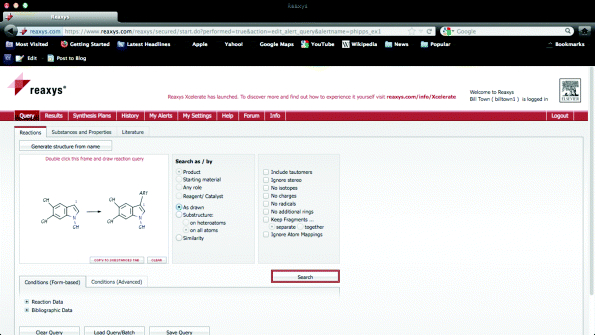
The Reaxys Version used in the above example is Application version: 1.0.9619; Content last updated: February 2012; Reactions: 31.681.788; Substances: 20.286.045; Citations: 4.504.504. Figure A.8 shows details for one of the reactions returned for this search. Also shown on this screen are various parameters that are available to search for this example. The original publication from which the reaction was taken is readily available.
Fig. A.8 One reaction returned for this search.
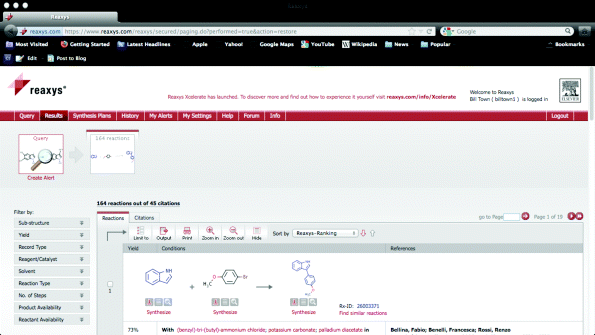
It is also possible to expand the literature review by viewing the details of any recent articles that cite articles of interest. This is easily achieved by clicking on the ‘view citing articles’ hyperlink. The reaction shown in Fig. A.8 was cited in the patent literature and also in the Journal of Organic Chemistry, as shown in Fig. A.9. In this manner, relevant, more recent articles may be identified and explored using citation data from Scopus. A few of such citations are shown in Fig. A.10.
Fig. A.10 Other potentially relevant papers based on an expanded search.
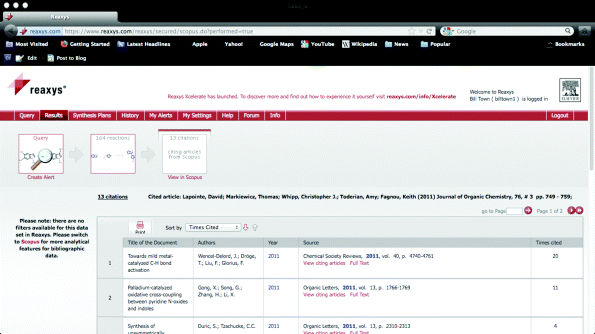
The synthesis planning tool allows a more in depth investigation. The Reaxys synthesis tool makes it easy to add more steps to the synthesis plan by searching the journal and patent literature for reactions designed to prepare the precursor molecules in any reaction step. Figure A.11 illustrates how a synthesis of a target that is consistent with the original search parameters may be constructed. Extensive property data for chemical substances is available at every stage in the process. Reaxys is a valuable addition to the information resources used by synthetic chemists.
Fig. A.11 Synthesis plan for 3-phenylindole.

Note that Reaxys and the Reaxys® trademark are owned by Elsevier Properties SA and used under license. All rights reserved.
Notes
1. See Williams, S. College Teaching 2005, 53, 137 Kennedy, M.M. Educational Researcher 2007, 36, 139; Available at www.chemistryguide.org; Gallagher, G.J.; Adams, D.L. J. Chem. Educ. 2002, 79, 1368. Also see Wolman, Y. Chemical Information, 2nd ed., Wiley, NY, 1988; Maizell, R.E. How to Find Chemical Information, 2nd ed., Wiley, NY, 1987; Mellon, M.G. Chemical Publications, 5th ed., McGraw-Hill, NY, 1982; Skolnik, H. The Literature Matrix of Chemistry, Wiley, NY, 1982; Antony, A. Guide to Basic Information Sources in Chemistry, Jeffrey Norton Publishers, NY, 1979; Bottle, R.T. Use of the Chemical Literature, Butterworth, London, 1979; Woodburn, H.M. Using the Chemical Literature, Marcel Dekker, NY, 1974. For a three-part article on the literature of organic chemistry, see Hancock, J.E.H. J. Chem. Educ. 1968, 45, 193, 260, 336.
2. For examples of the contents of an academic electronic library see http://lib.uconn.edu/ or http://www.chem.ox.ac.uk/cheminfo/ejournals.html. Also see eJournal Locator.
3. In some journals, notes are called “short communications”, an unfortunate practice, because they are not communications as that term is defined in this text.
4. In Table A.1, notes are counted as papers.
5. These journals are available in English translation.
6. These journals also publish review articles regularly.
7. Each issue of this journal is devoted to a specific topic.
8. Before 1978 this journal was called Roczniki Chemii.
9. Pure Appl. Chem. publishes IUPAC reports and lectures given at IUPAC meetings.
10. Before 1989 this journal was called Reviews of Chemical Intermediates.
11. Adobe Acrobat files.
12. Available at www.google.com/
13. See http://scientific.thomson.com/products/categories/citation/
14. Title pages of organic chemistry journals are also carried by Current Contents Life Sciences, which is a similar publication covering biochemistry and medicine.
15. Available at http://scientific.thomson.com/products/ccc/
16. For example, Chem. Ind. (London) publishes abstracts of papers that appear in other journals. In the past, journals, such as J. Am. Chem. Soc., J. Chem. Soc., and Ber. also did so.
17. For a guide to the use of CA, see Schulz, H. From CA to CAS ONLINE; VCH: NY, 1988.
18. Began in 1967. See Appendix A.B.ii.
19. These abbreviations are changed from time to time. Therefore the reader may notice inconsistencies.
20. See http://www.cas.org/expertise/cascontent/registry/regsys.html
21. An “obituary” of Zentralblatt by Weiske, C., gives its history and statistical data about its abstracts and indexes, and was published in the April 1973 issue of Chem. Ber. (pp. I–XVI).
22. For a discussion of how data are processed for inclusion in Beilstein, see Luckenbach, R.; Ecker, R.; Sunkel, J. Angew. Chem. Int. Ed. Engl. 1981, 20, 841 [Angew. Chem. 93, 876].
23. For descriptions of the Beilstein system and directions for using it, see Sunkel, J.; Hoffmann, E.; Luckenbach, R. J. Chem. Educ. 1981, 58, 982; Luckenbach, R. CHEMTECH 1979, 612. The Beilstein Institute has also published two English language guides to the system. One, available free, is How to Use Beilstein, Beilstein Institute, Frankfurt/Main, 1979. The other is by Weissbach, O. A Manual for the Use of Beilstein's Handbuch der Organischen Chemie, Springer, NY, 1976. An older work, which many students will find easier to follow, is by Huntress, E.H. A Brief Introduction to the Use of Beilstein's Handbuch der Organischen Chemie, 2nd ed., Wiley, NY, 1938.
24. In some cases, to keep the system parallel and to avoid books that are too big or too small, volumes are issued in two or more parts, and, in other cases, two volumes are bound as one.
25. Most page number entries in the combined indexes contain a letter (e.g., CHBr2Cl 67f, II 33a, III 87d, IV, 81). These letters tell where on the page to find the compound and are useful because the names given in the index are not necessarily those used in the earlier series. The letter “a” means the compound is the first on its page, “b” is the second, and so on. No letters are given for the fourth supplement.
26. Basset, J.-M.; Copret, C.; Soulivong, D.; Taoufik, M.; Cazat, J.T. Acc. Chem. Res. 2010, 43, 323.
27. Darses, S.; Genet, J.-P. Chem. Rev. 2008, 108, 288.
28. Ding, H.; Friestad, G.K. Synthesis 2005, 2815.
29. Successor to Quarterly Reviews (abbreviated as Q. Rev., Chem. Soc.).
30. Formerly called Fortschritte der Chemischen Forschung.
31. Smith, J.D.; Walton, D.R.M. Adv. Organomet. Chem. 1975, 13, 453.
32. Bruce, M.I. Adv. Organomet. Chem. 1972, 10, 273, 1973, 11, 447, 1974, 12, 380.
33. Belen'kii, L.I. Adv. Heterocycl. Chem. 1988, 44, 269; Katritzky, A.R.; Jones, P.M. Adv. Heterocycl. Chem. 1979, 25, 303; Katritzky, A.R.; Weeds, S.M. Adv. Heterocycl. Chem. 1966, 7, 225.
34. Available at http://www.orgsyn.org/
35. For a monograph that covers both online searching and searching using printed materials, see Wiggins, G. Chemical Information Sources, McGraw-Hill, NY, 1991.
36. Compounds newly reported in the fifth supplement that are in a volume whose index has not yet been published will not be found by this procedure. To find them in Beilstein, it is necessary to know something about the system, but they may also be found by consulting SciFinder.
37. For those heterocyclic compounds that would naturally belong to a volume for which the fifth supplement has been published.
38. Available at http://www.cas.org/EO/regsys.html
39. Available at http://www.cas.org/
40. Available at http://ptcl.chem.ox.ac.uk/MSDS/glossary/casnumber.html
41. Available at http://www.cas.org/EO/checkdig.html
42. Available at http://www.cas.org/
43. Available at http://www.cas.org/SCIFINDER/SCHOLAR/interact/
44. Available at http://www.cas.org/SCIFINDER/SCHOLAR/page2a.html
45. Available at http://www.cas.org/SCIFINDER/SCHOLAR/scholstruc.html
46. Available at http://www.cas.org/ONLINE/STN/discover.html
47. Available at http://www.cas.org/stn.html
48. Available at http://www.cas.org/ONLINE/STN/expressmac.pdf
49. Available at http://www.cas.org/SCIFINDER/topic.html
50. Available at http://www.cas.org/SCIFINDER/author.html
51. Available at http://www.cas.org/SCIFINDER/structure.html
52. Registered trade name.
53. Available at https://www.reaxys.com/info/
54. Available at Reaxys_whitepaper_2011_whatsinReaxys.pdf
